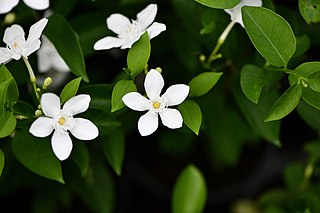
The American tree sparrow, also known as the winter sparrow, is a medium-sized New World sparrow.

Gmelina arborea,, locally known as gamhar, is a fast-growing deciduous tree in the family Lamiaceae.

Wrightia is a genus of flowering plants in the family Apocynaceae, first described as a genus in 1810. It native to tropical Africa, China, the Indian Subcontinent, Southeast Asia, Papuasia, and Australia. The species are all small trees or shrubs.

Pandanaceae is a family of flowering plants native to the tropics and subtropics of the Old World, from West Africa through the Pacific. It contains 982 known species in five genera, of which the type genus, Pandanus, is the most important, with species like Pandanus amaryllifolius and karuka being important sources of food. It is an ancient family dating from the early to mid-Cretaceous. This is a family that is not-well studied.

Banksia arborea, commonly known as Yilgarn dryandra, is a species of tree that is endemic to Western Australia. It has serrated, sharply pointed leaves, and yellow flowers and is found inland north of Southern Cross.

Gmelina is a genus of plants in the family Lamiaceae. It consists of about 35 species in Australia, New Guinea, New Caledonia, Southeast Asia, India and a few in Africa. Some species such as G. arborea have been planted and/or become naturalised in India, Africa and Australia. It was named by Carl Linnaeus in honour of botanist Johann Georg Gmelin.

Butomus is the only known genus in the plant family Butomaceae, native to Europe and Asia. It is considered invasive in some parts of the United States.

Hypericum canariense is a species of flowering plant in the family Hypericaceae known by the common name Canary Islands St. John's wort. It is the sole member of Hypericumsect. Webbia.

Cypella is a genus of herbaceous, perennial and bulbous plants in the family Iridaceae. It is distributed in South America, from Peru and Brazil to Northern Argentina. The genus name is likely derived from the Greek word kyphella, meaning "hollow of the ear", and alludes to the shape of the inner tepals.

Wrightia tinctoria, Pala indigo plant or dyer's oleander, is a flowering plant species in the genus Wrightia found in India, southeast Asia and Australia. It is found in dry and moist regions in its distribution. Various parts of the plant have been used in traditional medicine, but there is no scientific evidence it is effective or safe for treating any disease.

Wrightia antidysenterica, the coral swirl or tellicherry bark, is a flowering plant in the genus Wrightia. Wrightia antidysenterica is sometimes confused with the species Holarrhena pubescens due to a second, taxonomically invalid publication of the name Holarrhena pubescens. It has long been known in Indian Ayurvedic tradition. It is known in Sanskrit as kuṭaja or ambikā and in Sinhala it is called වල් ඉද්ද. It is also known as "white angel" in the Philippines and in Thailand it is called "พุดพิชญา" (pudpitchaya).

Engelhardia spicata is a species of plant in the Juglandaceae family. It is recognized to include the variety E. spicata var. integra(Kurz) W.E. Manning ex Steen.

Periploca is a genus of plants in the family Apocynaceae, first described for modern science by Linnaeus in 1753. It is native to Europe, Asia, and Africa.
- Periploca aphyllaDecne. - Middle East from Sinai to Pakistan
- Periploca calophylla(Wight) Falc. - S China, Nepal, Bhutan, Assam, E Himalayas, Vietnam
- Periploca chevalieriBrowicz - Cape Verde Islands
- Periploca chrysanthaD.S. Yao, X.D. Chen & J.W. Ren - Gansu Province in China
- Periploca floribundaTsiang - Yunnan, Vietnam
- Periploca forrestiiSchltr. - Guangxi, Guizhou, Qinghai, Sichuan, Tibet, Yunnan, India, Kashmir, Myanmar, Nepal
- Periploca graecaL. - Mediterranean
- Periploca hydaspidisFalc. - Kashmir
- Periploca laevigataAiton - Canary Islands, Savage Islands
- Periploca linearifoliaQuart.-Dill. & A. Rich - Ethiopia
- Periploca nigrescensAfzel. - W Africa
- Periploca refractifoliaGilli - Tanzania
- Periploca sepiumBunge - widespread across much of China
- Periploca tsiangiiD. Fang & H.Z. Ling - Guangxi Province in China
- Periploca visciformis(Vatke) K. Schum. - Somalia

Xylorhiza adusta is a species of beetles in the longhorn beetle family (Cerambycidae).

Wrightia religiosa is a species of tree in the family Apocynaceae. Its distribution includes: China (Guangdong), Indochina and Malaysia including the Philippines; no subspecies are listed in the Catalogue of Life.

Peritoma is a genus in the plant family Cleomaceae with six species of shrubs and annuals. All six species are native to North America, concentrated mostly in southern California, and with large populations in the rest of the western United States and northwestern Mexico. The name "Peritoma" is derived from the Ancient Greek words "peri" (περί), meaning "about" or "around," and "toma" or "tome" (τομή), meaning "cut." The name "cut-around" refers to the calyx that splits around its middle as the fruit dehisces.

Xanthisma spinulosum is a species of flowering plant of the genus Xanthisma native to western North America.

Vitis bellula, commonly known as the beautiful grape or small leaf hair grape, is a Chinese liana in the grape family. It is native to the provinces of Guangdong, Guangxi, Hubei, Hunan, and Sichuan. The plant grows at altitudes of 400–1,600 m (1,300–5,200 ft) and bears medium-sized purplish-black grapes.

















